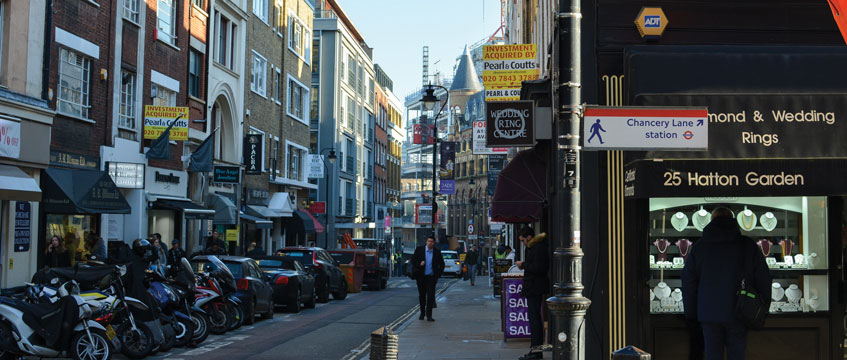The future of London’s diamond district is under threat as jewellers battle with soaring rents that could drive them out of their historic home.
Hatton Garden, EC1, is the centre of the diamond trade in the UK, but traders are being squeezed by rising rents fuelled by the arrival of Crossrail.
Tony Dellow, a jeweller based in Hatton Garden since 1976, said the district “faces extinction” as a result. “I would be very surprised if Hatton Garden is still here in five years as a jewellery quarter,” Dellow said. “It is in decline. Only 25% of the street is jewellers now.”
Dellow is among several traders facing sharp rent increases this year. “I have been in negotiations with my landlord since September last year,” he said. “I took over my shop five years ago and my lease is up for renewal in April. I am paying £36,000 a year in rent and my landlord wanted £92,000 per year.”
Gary Williams, director at local jewellery scrap firm Presman Mastermelt and chairman of the Hatton Garden Business Improvement District, said he is supporting tenants in their negotiations with landlords.
“I have to try and intercede on behalf of tenants in some cases because they can’t sustain their businesses,” he adds. “There are certain leases up for renewal where landlords are doubling and trebling the rents.”
Rents in Farringdon, EC1, have nearly trebled over the past decade from an average of £25 per sq ft to £65.5 per sq ft, according to data from agency Savills. Although not all traders have experienced such sharp hikes in rent, many remain concerned about the possibility of eviction.
Amanda Mansell, a jewellery designer, said: “My landlord has been pretty fair with me but I know that this is not the case with a lot of people. To some extent I can plan for rent rises, but the real threat is possible eviction and the landlord selling the building to redevelop it into plush offices.”
Poor quality workspace handed over by developers under section 106 arrangements is yet another worry.
“If councils manage to get an area for jewellers, they get basement space,” said Williams. “We are looking at stones and manufacturing close-up products, so lighting is a big issue.”
BID breakthrough or bust up?
The first term of Hatton Garden’s BID ends next year, and plans for a second are currently being drawn. BIDs, originally a Canadian concept, are becoming a popular way for companies to club together to regenerate high streets. Tenants in an area pay a levy that goes towards local initiatives.
But Hatton Garden’s future is unclear. Office occupiers are becoming a more prominent force in the area and gentrification seems inevitable with Crossrail looming.
Formed in October 2015, the BID is led by regeneration consultancy Primera. Primera programme director Sarah Nelson said: “Our first five-year term [2016-2021] has been very operational, focused on events and networking. The second term will be more strategic; we are looking at big projects including pedestrianisation, supporting Leather Lane market and applying for a Creative Enterprise Zone.”
The BID will also look at levy payments and how much it will charge its 385 members. Currently, businesses in properties with a rateable value of £100,000 or below do not have to pay. “A lot of the jewellery business falls below that,” Nelson said. “We don’t want to penalise them.”
Above that threshold, members pay 1.5% of the rateable value of their property. The jewellery sector accounts for 16% of all levy payments.
The group claims to have a broad focus and aims to represent all types of businesses in the area. “The BID is absolutely not just jewellery focused,” said Alistair Subba Row, Farebrother senior partner and appointed adviser to the BID board. “We can’t forget that this is London’s home for the jewellery trade but there are a significant number of office occupiers and other retailers within the BID area.”
For many jewellery traders, a big part of BID membership is survival. Williams said: “When I initially heard about the impact Crossrail would have on Hatton Garden I proposed putting a BID forward because I thought Crossrail would be highly detrimental to the jewellery trade, [and] at least if I was at the forefront of the BID we would have a voice along the way.”
Those voices have not been unchallenged. One former BID board member highlighted the dichotomies the organisation faces. He said: “Put bluntly, jewellers can’t afford to pay the rents that maybe Pret or other retailers can.
“The interests of stakeholders are not really aligned. If you’re an office worker at Hatton Garden, you’re not particularly interested in whether you can buy a diamond at lunch time. What’s more important is, can I get a sandwich?”
To send feedback, e-mail anna.ward@egi.co.uk or tweet @annaroxelana or @estatesgazette











